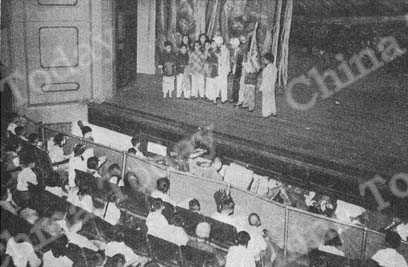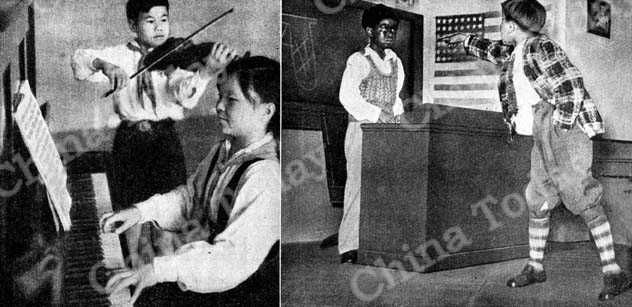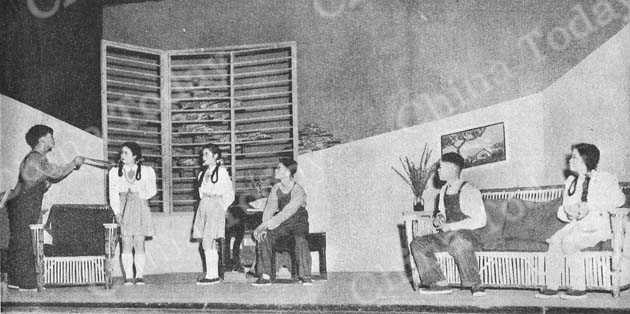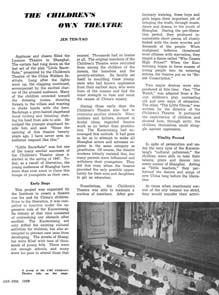Applause and cheers filled the Lyceum Theatre in Shanghai. The curtain had rung down on the last act of the play "Little Snowflake," presented by the Children's Theatre of the China Welfare Institute. Long after the lights went up, the clapping continued, accompanied by the excited chatter of the aroused audience. Many of the children crowded toward the dressing rooms, shouting threats to the villain and wanting to shake hands with the hero. Backstage a grey-haired stagehand stood looking and listening, shaking his head from side to side. He nudged the younger stagehand beside him and said: "Since the opening of this theatre twenty years ago, I have never seen an audience respond like this."
"Little Snowflake" was but one of the many similar successes of the Children's Theatre since it started in the spring of 1947. Today, as a result of liberation, the young audiences of Shanghai have more than ever come to claim this troupe of youngsters as their own.
Early Steps
This project was organized by the Institute to create a theatre run for and by China's children. Prior to the liberation, it was compelled to function under the oppressive rule of the Kuomintang. Its history at that time consisted of overcoming one obstacle after another. The Kuomintang not only stifled the existing cultural activities for children, but also attempted to prevent new ones from developing. The streets of Shanghai were filled with tens of thousands of young folk. There were not enough schools, and many were too poor to attend those that existed. Thousands had no homes at all. The original members of the Children's Theatre were recruited from among the children of the streets, the homeless and the poverty-stricken. Its faculty set itself to moulding these youngsters who had known oppression from their earliest days, who were born of the masses and had the inner strength to hate and resist the causes of China's misery.
During those early days the Children's Theatre also had to overcome another obstacle. Many mothers and fathers, steeped in feudal ideas, regarded theatre work as no better than prostitution. The Kuomintang had encouraged this outlook. It had gone so far as to attempt to make all Shanghai actors and actresses register in the same category as prostitutes. Of course, the theatre workers bitterly resisted this, but many parents were influenced and withdrew their youngsters. They did this even when the theatre provided the only possible opportunity for their sons and daughters to get an education.
Nonetheless, the Children's Theatre was able to maintain a nucleus of members. After preliminary training, these boys and girls began their important job of bringing the truth, through music, dance and drama, to the youth of Shanghai. During the pre-liberation period, they produced innumerable short pieces, all closely linked with the main worries and demands of the people. When malignant inflation threatened most citizens with starvation, they staged a dance called "Who Causes High Prices?" When the Kuomintang began to force masses of young people into its tottering armies, the theatre put on its "Resist Conscription."

A group of the CWI Children's Theatre kids on the stage.
Two major dramas were also produced at this time. One, "The Watch," was adapted from a Soviet children's play contrasting old and new ways of education. The other, "The Little Circus," was written by the director of the Children's Theatre. It portrayed the exploitation of children and showed how, through unity, the children themselves could struggle against oppression.
Vitality Proved
In spite of persecution and under the very eyes of the Kuomintang's "cultural policemen," the children were able to take their talents, plays and dances into every corner of Shanghai. Acting as "little teachers," they performed the dances and songs of new China long before the liberation.
At times when reactionary control of the city became too strict, they would transfer their activities to the rural areas. In August 1948, for example, they visited the "Boys' Town" farm, a collecting and educational centre for Shanghai's delinquent and beggar children. A cultural troupe was organized among the youngsters, opening their eyes to the fact that, in a people's society, their lives could be filled with hope and happiness. This was a new application of the theatre's experience during the previous summer vacation, when its members had trained over 100 children so that they could organize dramatic activities in their own schools when the holiday was over.

Violinist and accompanist of the music section of the CWI Children's Theatre. "Little Snowflake" - a play of solidarity with the Negro people of the U.S.
The "Boys' Town" work brought new threats from the Kuomintang, so the Children's Theatre moved back into Shanghai. More plays were developed, and performances in a great number of schools were lined up. However, at the last minute, many teachers cancelled the scheduled shows under Kuomintang pressure. The theatre countered by establishing close contact with the progressive Teachers' Union and putting on plays with "no preparation and no publicity." Under this system, courageous teachers guaranteed that audiences could be present, mobilizing their pupils quietly. Both the Children's Theatre and the audience would show up unannounced at a prearranged time and place, and the show would go on. Many schools and thousands of young people continued to be served in such ways.
In the last days of reactionary rule, marked by frantic Kuomintang arrests and executions, the Children's Theatre split into groups which were dispersed to various parts of Shanghai. These remained in hiding, rehearsing their plays until the People's Liberation Army arrived. Then the Children's Theatre reappeared in the streets as a publicity team, performing on corners and in the lanes and terraces, explaining to the people what the liberation meant for them.
These efforts endeared the Theatre to the whole population, both children and grown-ups.
Under New Conditions
Since the liberation, the Children's Theatre has settled down to become one of the main cultural influences among the children of Shanghai and the whole nation. It is now entrusted with leadership in lifting the level of children's dramatics throughout China. Bearing this responsibility, the young members and faculty are working seriously and making long-range plans. They are struggling to lift their own technique, to deepen their own understanding of the strength of the new China. In keeping with the basic policy of the China Welfare Institute, they have begun to conduct their theatre as an experiment, as a model for the rest of the country.
The present members of the theatre are boys and girls who have been especially selected for talent. As was the case with the original members, many of whom have since grown up and entered the general stream of national cultural advance, they live and study collectively. Their training is based on the principle of linking study with practical work. They are divided into four sections: drama, dancing, music and art. In addition to receiving specialized technical training, each child also studies regular school subjects.
On the technical side, the children in the dramatic section are taught how to analyze a play and to take various parts. They are encouraged to write their own plays and have revealed great creativeness. The youngsters come mainly from working families and have themselves known both poverty and hard struggle for a better life. This brings their writing especially close to the actual experience of the vast majority of our people, both the bitterness of the past and the great energies released now that the people know they can change all things by their own efforts.

"The Watch," another play presented by the CWI Children's Theatre.
Children in the art section are responsible for lighting, scenery, properties and costumes. Those in the music section have their own Chinese orchestra and another orchestra with European instruments. The dance section performs Chinese classical dances, ballets and modern dance. The music and dance sections try both to preserve the old national forms of China and to make them blend satisfactorily with forms originating elsewhere.
People of a New Kind
The relationship among the youngsters of the Children's Theatre is healthy and comradely. Their whole education is aimed toward developing self-government, mutual help and cooperation. Together, they summarize and draw conclusions from their work. They are taught to be open and frank at meetings, to bring up suggestions and debate hotly until they find a solution for the problems discussed. They have their own blackboard newspapers and wall bulletins, filled both with praise and criticism. Most of the theatre's youngsters have either become members of the Young Pioneers or the New Democratic Youth League, or are preparing to enter these organizations. One of the girl actors was among those selected to spend the summer in a Bulgarian Young Pioneers camp.
In brief, the members of the CWI Children's Theatre are good examples of the new type of Chinese youth, honest in mind and healthy in body, willing to receive and ready to give constructive criticism. Their qualities are the very ones on which the building of our new society is based, the qualities China prizes most highly in her citizens.
Character development of this kind helps the children in their chosen profession. Its results appear whenever the Children's Theatre performs. One can see them most vividly every June 1, on International Children's Day, the high point of each year's activity.
It was on June 1, 1950, that the Theatre first presented "Little Snowflake." The play describes the persecution of the Negro people in the United States and shows how the struggle against this persecution is organized. "Little Snowflake" went into more than thirty performances. Its young audiences followed it with unusual concentration. They loudly sympathized with the Negro hero, and demanded punishment for the bigoted villain.
On International Children's Day in 1951, the theatre presented a dance pantomime, "Always Be Prepared." The title itself is the motto of China's Young Pioneers, and the pantomime portrayed the history and present activities of the organization. Beginning with scenes of children's life in the old liberated areas it brought the story to the Mao Tse-tung era throughout the nation. Through the medium of dance, it showed why Chinese children should study hard, play hard, and develop every faculty so as to be ready at all times for the construction and defence of their country. "Always Be Prepared" played to full houses and enthusiastic audiences for three weeks.
No less than 95,000 people witnessed Children's Theatre performances in the first half of 1951.
At present, the members and faculty of the Children's Theatre continue to train and prepare. Their objective is the rapid extension and development of children's theatres as part of the tide of cultural growth in China today.


 Copy Reference
Copy Reference 